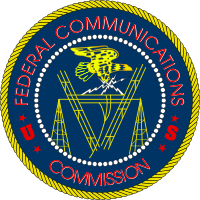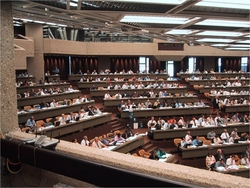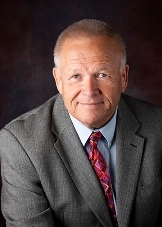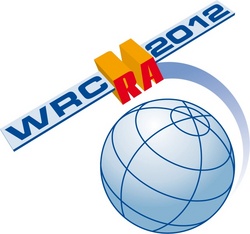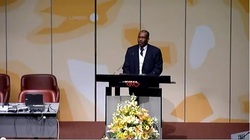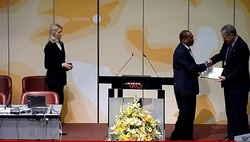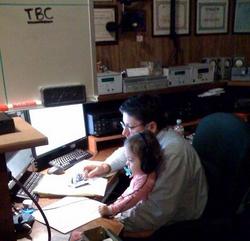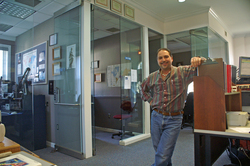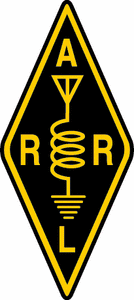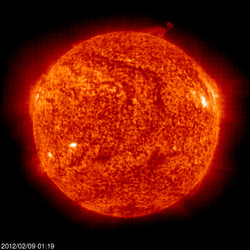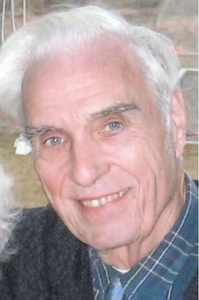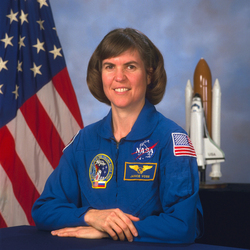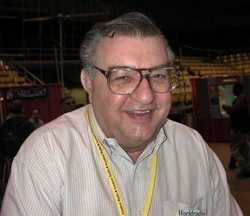 February 9, 2012 John E. Ross, KD8IDJ, Editor
| |||||||||||||||
+ Available on ARRL Audio News. + FCC News: New Rules for 5 MHz (60 Meters) To Go Into Effect March 5
On November 18, the FCC released a Report and Order, defining new rules for the 60 meter (5 MHz) band. These rules are in response to a Petition for Rulemaking filed by the ARRL more than five years ago and a June 2010 Notice of Proposed Rulemaking. In the February 3 edition of the Federal Register, the FCC announced that these new rules will go into effect on March 5, 2012. Read more here. + WRC-12: Agenda Item 1.23 Passes Committee, Moves to Plenary
On the afternoon of February 7, Committee 4 of the 2012 World Radiocommunication Conference (WRC-12) approved Option 1 to satisfy Agenda Item 1.23, with minor editorial amendments to the text received from Working Group 4C. Option 1 calls for a worldwide secondary allocation to the Amateur Service at 472-479 kHz, with a power limit of 1 W EIRP, with a provision for administrations to permit up to 5 W EIRP for stations located more than 800 km from certain countries that wish to protect their aeronautical radionavigation service (non-directional beacons) from any possible interference. Option 2 was NOC (no change to the current rules). In keeping with the rules of the Conference, Committee decisions must be read twice in Plenary Session; the decision of the Conference is not final until after second reading in Plenary. According to ARRL Chief Executive Officer David Sumner, K1ZZ, quite a few additional administrations -- mainly in the former Soviet Union and Arab states -- will be adding their country names to the Footnotes prior to consideration in Plenary. Sumner said that Agenda Item 1.23 should have its first reading in the Plenary on Friday, February 10, with its second reading sometime next week. Read more here. + WRC-12: How Are Agenda Items Processed at a WRC? By IARU Secretary Rod Stafford, W6ROD
The procedures used by the International Telecommunication Union before and during a World Radiocommunication Conference seem complicated. They are somewhat complicated, but they are understandable with a bit of background. Each Agenda Item that will be decided at a WRC has been studied for at least three or four years leading up to a WRC. ITU Study Groups and Working Parties discuss the issues involved in the Agenda Item. Compatibility studies, sharing studies and experiments take place whenever needed, so that discussions and decisions can be made based upon facts, rather than opinions. Read more here. + WRC-12: Proposed Maritime Mobile Allocation Gets First Reading at WRC-12 Plenary Session
At the February 3 Plenary Session of the 2012 World Radiocommunication Conference (WRC-12), delegates heard the first reading and approved a worldwide exclusive allocation to Maritime Mobile of 495-505 kHz. There will need to be a second reading to finalize the allocation. According to ARRL Chief Executive Officer David Sumner, K1ZZ, discussion of this allocation to Maritime Mobile "has been in the works throughout the conference preparation (i.e. since 2008) and was the reason why the MF amateur allocation could not be made in this band as some amateurs had hoped. That's why we [the Amateur Radio Service] had to look elsewhere and is what put us in conflict with aeronautical radionavigation." + WRC-12: Nobel Laureate Joe Taylor, K1JT, Addresses Plenary Session at WRC-12, Receives ITU Gold Medal On February 3, delegates and attendees at the 2012 World Radiocommunication Conference had the pleasure of listening Joe Taylor, K1JT, share his vision of the future of radiocommunication. Taylor -- an ARRL Member -- won the Nobel Prize in physics in 1993 for the discovery of a binary pulsar, a discovery which has opened up new possibilities for the study of gravitation. After the speech, International Telecommunication Union Secretary General Dr Hamadoun Touré, HB9EHT, presented Taylor with the ITU Gold Medal in recognition of Taylor's outstanding contribution to the research in the field of radiocommunication.
Dr Touré introduced Taylor to the Plenary. In his introduction, he told the audience that Amateur Radio led to Taylor's career as a radio astronomer, and ultimately to his winning the Nobel Prize: "I'm told that an early interest in Amateur Radio led Joe Taylor to an exciting career in radio astronomy, which then earned him the 1993 Nobel Prize in physics. I share his interest in Amateur Radio with passion, but will that lead me to a Nobel Prize? I'm working on it!" Taylor began his speech by thanking the WRC-12 delegates for the job they were doing at the Conference. "I understand that you have come to Geneva from more than 150 of the ITU's Member States," he said. "You are here to do an important job, an essential one, for nearly all of humanity in today's world. You are charged to do your upmost to accommodate the wide variety of competing interests of all users of the radio frequency spectrum and its available orbits for Earth satellites. This is surely not an easy task. Most people give very little thought to the complicated issues that you face. Why should they, since for most of us, most of the time, the technologies that depend on these limited resources just seem to work. But I know, and each one of you knows, that much background work and many long negotiations are often necessary in order to make everything fit together and work in harmony." Taylor noted new discoveries "that have fundamentally changed or expanded our understanding of nature's laws, or might do so in the near future." But, he said, these discoveries will not affect the ITU or future WRCs for "at least not for many decades to come. This is because our fundamental understanding of electromagnetism is already in a mature state. Maxwell's equations, after all, have been thoroughly tested now for 150 years. And in principle, they tell us everything we need to know in order to exploit the wonders of telecommunications at the speed of light. Our understanding of these laws of nature, including what they tell us is possible and not possible, is not likely to change, even in the more distant future. But of course we can still develop new and improved ways of generating, controlling and detecting electromagnetic radiation, as well as clever new ways of effectively sharing the spectral resources that we have. Such advances as these will surely continue, and perhaps they will even increase. The fundamental science may be mature, but technology's ability to exploit and build upon electromagnetic phenomena is still rapidly developing.
"It's interesting to comment in passing on the fundamental differences between the bounded radio frequency spectrum and the balance, for example, on accessible fossil fuels. Limitations of the radio spectrum are a result of fundamental laws of nature. Every nation on Earth, and indeed every person on Earth, has access, in principle, to the same spectrum as everyone else. The amount of accessible oil, on the other hand, depends on the much more complicated way on how the Earth formed and evolved over time, and fossil fuels are not evenly distributed over the Earth and they are expendable. When it's gone, there's none left. The electromagnetic spectrum, on the other hand, will always be there, whether or not we humans are around here to enjoy using it. Moreover, the spectrum can be shared by many users simultaneously, and shared use can be especially effective if adequate planning is done in advance. That planning, of course, is an essential part of your assignments here. "Future technologies will surely make even better uses of wireless communication than we do today. I foresee plenty of scope for contributions for new technologies. Information and communication technologies have much to offer for the betterment of the human condition everywhere, and perhaps especially so in the developing world. It is extremely important to continue seeking the best efficiencies in the use of the spectrum. I wish you every success in your task of creating wise and fair guidelines for regulators and policy makers who must allocate the limited resources in the very best interest of all mankind." You can view Taylor's speech on YouTube, courtesy of Andy Clegg, W4JE. On the Air: The 2012 ARRL International DX CW Contest Takes to the Air Next Weekend
CW DXing and contesting take center stage the weekend of February 18-19, as the 2012 ARRL International DX CW Contest takes to the airwaves. "After years of lackluster conditions on 15 and 10 meters, 2011 finally saw the propagation gods giving us a break," said ARRL Contest Branch Manager Sean Kutzko, KX9X. "Since September 2011, the high bands have been in excellent shape, with worldwide openings on 15 and 10 meters becoming an almost-daily occurrence. As a result, activity has spiked in almost every major contest, with hundreds more logs being submitted. If conditions hold -- and I don't see why they wouldn't -- we're in for another high-band treat in another week or so." Read more here. ARRL HQ: Save the Date! Take a Virtual Tour of W1AW on February 12 Join W1AW Station Manager Joe Carcia, NJ1Q, on a virtual tour of W1AW, the Hiram Percy Maxim Memorial Station, the Amateur Radio station at ARRL Headquarters in Newington, Connecticut. Carcia will lead this tour via a live webcast on Sunday, February 12 at 5 PM EST (2200 UTC). Anyone with an Internet connection will be able to watch the tour here.
"We want viewers of this live Internet tour to feel as if they are actually at W1AW," Carcia explained. "If you came to W1AW in person, you would see the same things that we are going to show on the virtual tour: The three operating stations, the W1AW workshop, the transmitter racks that we use to send out our bulletins and use for the code practice transmission, the control console and Old Betsy, Hiram Percy Maxim's personal spark gap transmitter." Al Petrunti, KA1TCH, of the New Day Group, will follow Carcia as he leads viewers through the station. ARRL Staff members, including Media and Public Relations Manager Allen Pitts, W1AGP, and Chief Operating Officer Harold Kramer, WJ1B, as well as local television weatherman Geoff Fox, K1GF, will also be on hand at W1AW during the tour. "Hams around the world know of W1AW, and thousands have made contacts with this impressive station -- but most hams never get to see it," Pitts said. "Thanks to Al Petrunti's group, we hope that folks enjoy seeing what's at the other end of the signals. As in all live broadcasts, you never know just what might happen. We invite you to join us." Pitts is producing the live web tour. This is the second video that the New Day Group has made for the ARRL. In 2011, they created the HR 607 video that educated radio amateurs of a bill in Congress that addressed certain spectrum management issues, including the creation and maintenance of a nationwide Public Safety broadband network using current Amateur Radio spectrum. + ARRL Field Day: 2012 Field Day Packet Now Available
It's that time of year again -- time to start gearing up for ARRL Field Day, June 23-24, 2012! ARRL's flagship operating event -- always held the fourth full weekend in June -- brings together new and experienced hams for 24 hours of operating fun. Field Day packets are now available for download and include the complete rules, as well as other reference items such as forms, ARRL Section abbreviation list, entry submission instructions, a Frequently Asked Questions section, guidelines for getting bonus points, instructions for GOTA stations and a kit to publicize your event with the local press. A brief one-page flyer with basic "What is Field Day" information has also been included in this year's Field Day packet. Amateur Radio clubs and individuals are encouraged to reproduce this flyer as a handout for information tables. Solar Update
Tad "The Sun rolling high through the sapphire sky" Cook, K7RA, reports: Solar activity was down again this week -- this is the third week in a row with sunspot numbers lower than the week prior. On January 20, we reported an average daily sunspot number of 116.9 for January 12-18, 98.7 the next week, followed by 62 the week of January 26-February 1, and now 40.4 during the latest period. The solar flux forecast -- which roughly tracks sunspot numbers; we don't have access to any short term sunspot number forecast -- is also lower. The latest forecast from NOAA/USAF has solar flux at 100 on February 9-11, 105 on February 12, and 110 on February 13-24. The predicted planetary A index is 8 on February 9-10, 5 on February 11, 8 on February 12-13, 5 on February 14-22, 8 on February 23, and 5 from February 24 through the end of the month. Look for more information on the ARRL website on Friday, February 10. For more information concerning radio propagation, visit the ARRL Technical Information Service Propagation page. This week's "Tad Cookism" is brought to you by Circle of Life from The Lion King. This Week in Radiosport This week:
Next week:
All dates, unless otherwise stated, are UTC. See the ARRL Contest Branch page, the ARRL Contest Update and the WA7BNM Contest Calendar for more information. Looking for a Special Event station? Be sure to check out the ARRL Special Event Stations Web page. Be a Star! Deadline for Second Annual ARRL Video Contest is February 29
If you've ever wanted a way to show the world how exciting Amateur Radio can be, here's your chance: The ARRL is sponsoring its Second Annual Video Contest! Here's a chance to put that video camera to use: Shoot a ham radio-related video and send it our way. All videos must be postmarked by February 29, 2012. Burn your video to a CD or DVD using the appropriate software and mail it to ARRL Video Contest, 225 Main St, Newington, CT 06111. Do not attempt to send it via e-mail, as our e-mail system cannot accommodate large files. Read more here. + Silent Key: Former ITU-R Director Dick Kirby, W0LCT/HB9BOA (SK)
Richard "Dick" Kirby, W0LCT/HB9BOA, passed away on January 26. He was 89. In 1974, Kirby -- an ARRL Life Member -- was elected Director of the International Telecommunication Union's International Radio Consultative Committee; he served as Director until his retirement in 1995. In 1992, under Kirby's tenure as Director, the Committee became the ITU Radiocommunication Sector (ITU-R). One of three sectors at the ITU, ITU-R is responsible for matters concerning radio communication. Its role is to manage the international radio-frequency spectrum and satellite orbit resources, and to develop standards for radiocommunication systems with the objective of ensuring the effective use of the spectrum. While at the ITU, Kirby also served as President of the International Amateur Radio Club, 4U1ITU, the Amateur Radio station at ITU Headquarters in Geneva, Switzerland. Read more here. + Silent Key: Astronaut Janice Voss, KC5BTK (SK)
NASA astronaut Janice Voss, KC5BTK, of Houston, Texas, passed away on February 7 from cancer. She was 55. One of only six women who have flown in space five times, Voss' career was highlighted by her work and dedication to scientific payloads and exploration. Voss participated in making ham radio contacts from space via the Space Shuttle Amateur Radio Experiment (SAREX), the precursor to the Amateur Radio on the International Space Station (ARISS) program. Read more here. Silent Key: WorldRadio Founder Armond Noble, N6WR (SK)
Armond Noble, N6WR -- the founder of WorldRadio magazine and its publisher for 37 years -- passed away February 1 in Sacramento, California after a short illness. He was 77. WorldRadio was published monthly in printed form from July 1971 until the end of 2008, when Noble sold the magazine to Hicksville, New York-based CQ Communications Inc. With its February 2009 edition, the publication was renamed WorldRadio Online and became the first online-only major Amateur Radio publication . Read more here. Upcoming ARRL Section, State and Division Conventions and Events
To find a convention or hamfest near you, click here. ARRL -- Your One-Stop Resource for Amateur Radio News and Information Join or Renew Today! ARRL membership includes QST, Amateur Radio's most popular and informative journal, delivered to your mailbox each month. Subscribe to NCJ -- the National Contest Journal. Published bi-monthly, features articles by top contesters, letters, hints, statistics, scores, NA Sprint and QSO Parties. Subscribe to QEX -- A Forum for Communications Experimenters. Published bi-monthly, features technical articles, construction projects, columns and other items of interest to radio amateurs and communications professionals. Free of charge to ARRL members: Subscribe to the ARES E-Letter (monthly public service and emergency communications news), the ARRL Contest Update (bi-weekly contest newsletter), Division and Section news alerts -- and much more! Find us on Facebook. Follow us on Twitter. ARRL offers a wide array of products to enhance your enjoyment of Amateur Radio Donate to the fund of your choice -- support programs not funded by member dues! Click here to advertise in this newsletter. | |||||||||||||||
